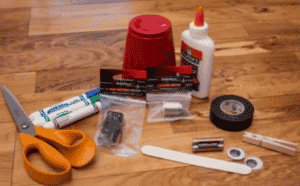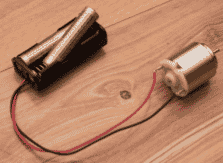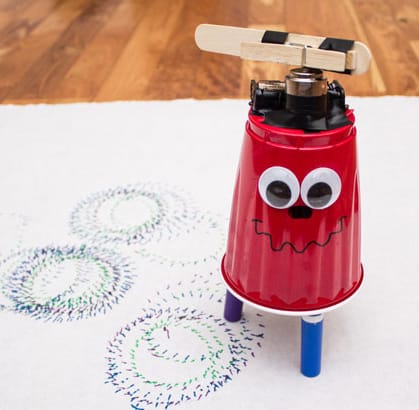Overview
STEM careers
Time
Materials
Per Child:
- Disposable cup

- Electrical tape
- 3 markers
- 2 AAA battery holder
- 2 AAA batteries
- 1.5V–3V DC motor
- Clothespin
- Popsicle stick
- Paper
- Scissors
- Permanent marker to draw face with
- Googly eyes and pipe cleaners for arms (optional)
- Glue (or hot glue gun; only needed if you use Googly eyes)
Instructions
 |
 |
Students hook up a simple DC motor to a battery in order to make a simple, fun robot that wiggles around on a piece of paper and makes its own abstract art.
Instruct students to make their wigglebots like this:

- Tape the markers inside the cup so that the tips of the markers protrude from the cup; these are the legs. It is important the tips are beyond the edge of the cup.
- To attach the battery holder to the DC motor, wrap the wire from the battery holder around the leads on the motor.
- Tape the battery holder (with the DC motor attached) to the top of the disposable cup, slightly off center. This might be easier if you make the tape narrower by cutting it lengthwise.
- Tape the motor onto the cup next to the battery holder.
- Place the batteries into the holder to test the motor and the wigglebot’s balance. There should not be too much wiggling at this point. Just make sure there is some vibration but the cup can balance. Adjust placement if needed.
- While the motor is still on, attach the clothespin to the top of the motor to make sure it does not cause the cup to fall.
- Turn the motor off and remove the clothespin. The goal is for the cup to wiggle as much as possible without parts falling off. To do this:
- Tape a popsicle stick to the clothespin.
- Cut a long, narrow piece of electric tape. Fold the end over the top of the motor. Then, wrap the remainder around the motor so that the sticky side is facing out.
- Attach the clothespin and popsicle stick to the tape-wrapped motor. The sticky part of the tape will adhere to the inside of the clothespin and hold it in place.
- Make a face on the wigglebot.
- Take the caps off the markers, plug the batteries in, and let the wigglebot go on a piece of paper. It will wiggle and spin, making its own art!
Guiding questions
-
What would happen if the legs weren’t all the same length? What if they were even longer?
-
What would happen if the wigglebot had more than 3 legs?
-
What could you do to make the wigglebot wiggle even more?
-
What if the motor were attached in a different spot? What if the motor and the battery pack were centered on top of the cup?
Engineering & science connections
- All robots—no matter how complex—require a power source and one or more motors. Engineers need to understand the basic principles of these before they can build more complicated robots.
- Other robots include drones, manufacturing robots and self-driving cars. There are more than a million robots in use today in industry alone.
- With “artificial intelligence” development, robots are expected to become more and more commonplace. Engineers at the Massachusetts Institute of Technology (MIT), in fact, are trying to build a robot that can respond to emotional cues.
- Engineers make motors for all kinds of machines, from toys to washing machines to cars. Robots are very important for space exploration. Two exploratory rovers, Spirit and Opportunity, are currently on Mars. They were designed to gather geological data and take pictures that are then transmitted to scientists on Earth. Both were built to last only for 90 days. Spirit lasted for 6 years, and Opportunity is still sending information back to Earth after 11 years.
This activity provided by Research Parent at http://researchparent.com/homemade-wigglebot.


Helpful but I think you should add what connection a wigglebot has to science too.
Hi Parth – Thanks for your suggestion. If you click on the + sign next to the Engineering & Science connections at the bottom of the page, you’ll see four different engineering applications for robots. Hope this helps!
Hello, I tried this and it…………… finally worked after a few tries a figured it out this bot is so much fun to watch and I had so much fun building it too